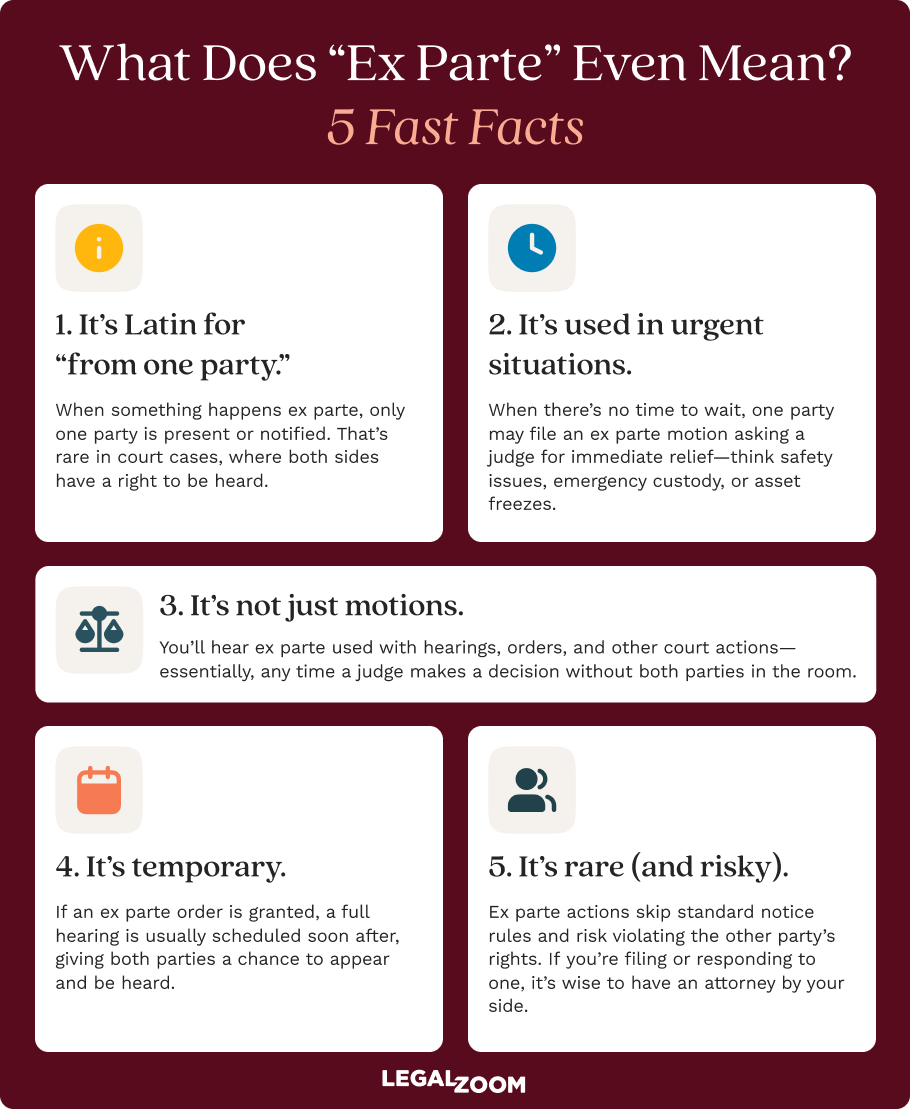An ex parte hearing refers to a civil procedure where only one party is present or represented before the court. In court cases, parties are entitled to notice and the opportunity to be heard. This is the basic concept behind due process, and everyone is entitled to it under the Fifth and Fourteenth Amendments.
In emergency situations, an ex parte motion provides an exception to the rules of due process by allowing you to petition the court without having to notify or serve the other parties involved in your case.
If the judge grants the ex parte order, the order is only temporary. The judge will hold a full hearing within a short period of time.

Ex parte meaning and uses
The term “ex parte” means "from one party” in Latin, which can describe any situation where a judge communicates with only one side (or one party's lawyer) in a legal matter.
Ex parte hearings are only granted in extreme cases, as they contradict the fundamental right to due process guaranteed by the Constitution. While commonly associated with emergency situations, ex parte can also refer to improper contact between a judge and one party if the rules aren’t followed.
Here are some examples of situations that might warrant an ex parte hearing:
- Domestic violence cases: A victim seeks immediate protection through a temporary restraining order.
- Child custody matters: A parent requests temporary sole custody when there’s immediate danger to the child’s safety.
- Temporary restraining orders: In cases of stalking or harassment, the petitioner wants immediate protection before the accuser is officially notified.
- Emergency asset freezes: One party requests to preserve another party’s assets out of concern they will destroy or hide them, such as in a divorce case.
Because ex parte hearings can risk violating the excluded party’s rights, courts have strict requirements for allowing them. The requesting party must prove the urgency of their situation and why notifying the other party would likely cause immediate harm, which ensures this exception is only used when absolutely necessary.
What is the procedure for an ex parte application?
The procedure for an ex parte application depends on the state, but here’s a general overview of how it typically works.
- Initial filing. In some states, you submit an ex parte application or motion to the judge along with your affidavit and any exhibits you want to attach. The purpose of this application is to convince the judge that you, as the petitioner, need an immediate order because of an urgent situation. The stronger your affidavit and supporting documents, the more likely you are to have an ex parte order granted.
- Judicial review. In some states, the judge will review the application and supporting documents and either grant or deny the ex parte order on the strength of the documents without meeting you. In other states, the judge will want you to appear and will ask you questions to determine whether your situation is a true emergency.
- Appearance. In many states, you present your ex parte application to the judge the same day you file it in court. The clerk will ask you to wait in the courthouse until the judge can either review the papers or until the judge wants to speak with you.
- Potential notice requirements. In other states, such as California, you must give notice to the other party the day before the emergency hearing or there's a risk of having the request denied. California's requirement of notice is unnecessary, though, if you can prove there's a serious risk of violence if the ex parte order is not granted.
Given the variations in state procedures—and the complexity of ex parte requests—it’s highly recommended to consult a local attorney familiar with your specific legal issue and jurisdiction’s requirements.
What happens after the judge reviews the ex parte motion?
Assuming the court accepts the request, the only thing that’s left is to meet for the ex parte court hearing.
At this stage, the judge can grant the ex parte motion and issue a temporary order, such as a temporary full custody order or a temporary restraining order. Because the other party was not present, the order is only temporary. Although the orders are often brief, they’re still legally binding and enforceable—with serious consequences for any violation.
Here are some examples of what ex parte orders can do:
- Prevent the other party from taking a child out of the country or state
- Prevent the other party from destroying property
- Prevent the other party from removing assets in a divorce proceeding
- Require the other party to stay away and not harass you
For an order to become permanent, the court has to hold a hearing, with both sides present, within a reasonable amount of time. Some states require a full hearing to occur within 10 days, while others require a full hearing in 14 to 20 days. The purpose of the hearing is to make sure the other party has been given their due process rights.
If the judge denies your ex parte application, a hearing may still be held shortly after the denial. You and the respondent both must appear at the hearing.
What happens at the full hearing?
Specific procedures and rules vary from court to court and state to state, but the full hearing process is generally similar. Mainly, you and the respondent present evidence through testimony and any other documents you may have, such as photos, hospital records, and police reports.
If you fail to appear at the hearing, the judge will dismiss the order. If the respondent fails to appear, it's likely you will receive a permanent order that is effective for approximately one year. In some states, the respondent's failure to appear allows the judge to grant a permanent order automatically.
If the respondent appears and doesn't contest the order, the ex parte order will convert to a permanent order without any testimony. If the respondent appears and objects to the order, there will be a trial. You and the respondent will each testify and present evidence. Then it's up to the judge to determine whether you need a permanent order or whether to dismiss the petition.
FAQs
How much does it cost to file an ex parte application?
The costs of filing an ex parte application vary by jurisdiction. In most cases, you’ll pay a standard court filing fee, which may range from $50 to $400. However, fee waivers may be available for those who can’t afford the filing costs.
Do I need a lawyer for an ex parte hearing?
While not required, having a lawyer for an ex parte hearing—or any civil procedure—is highly recommended. The process for ex parte hearings can be complex, and you’ll want to work with a lawyer who can effectively present your case to the judge.
Are ex parte orders permanent?
Ex parte orders are typically temporary. They usually remain in effect only until a full hearing can be held with both parties present, usually within 10 to 20 days, depending on the jurisdiction.
Can the other party contest an ex parte order?
Once notified of the order, the other party has the right to request a hearing and contest the judge's decision. At this hearing, the other party (or the other party's lawyer) presents evidence and arguments, after which the judge can decide whether to maintain, modify, or dissolve the temporary order.
What does it mean to proceed ex parte?
Proceeding ex parte means to move forward with legal action without the presence or input of the other party. In court, it typically refers to emergency situations where one party seeks immediate relief. However, legal ethics rules and civil procedure typically forbid one-sided legal proceedings, so there are strict rules that must be followed in ex parte matters to avoid improper conduct.
Ronna L. DeLoe, Esq. contributed to this article.


